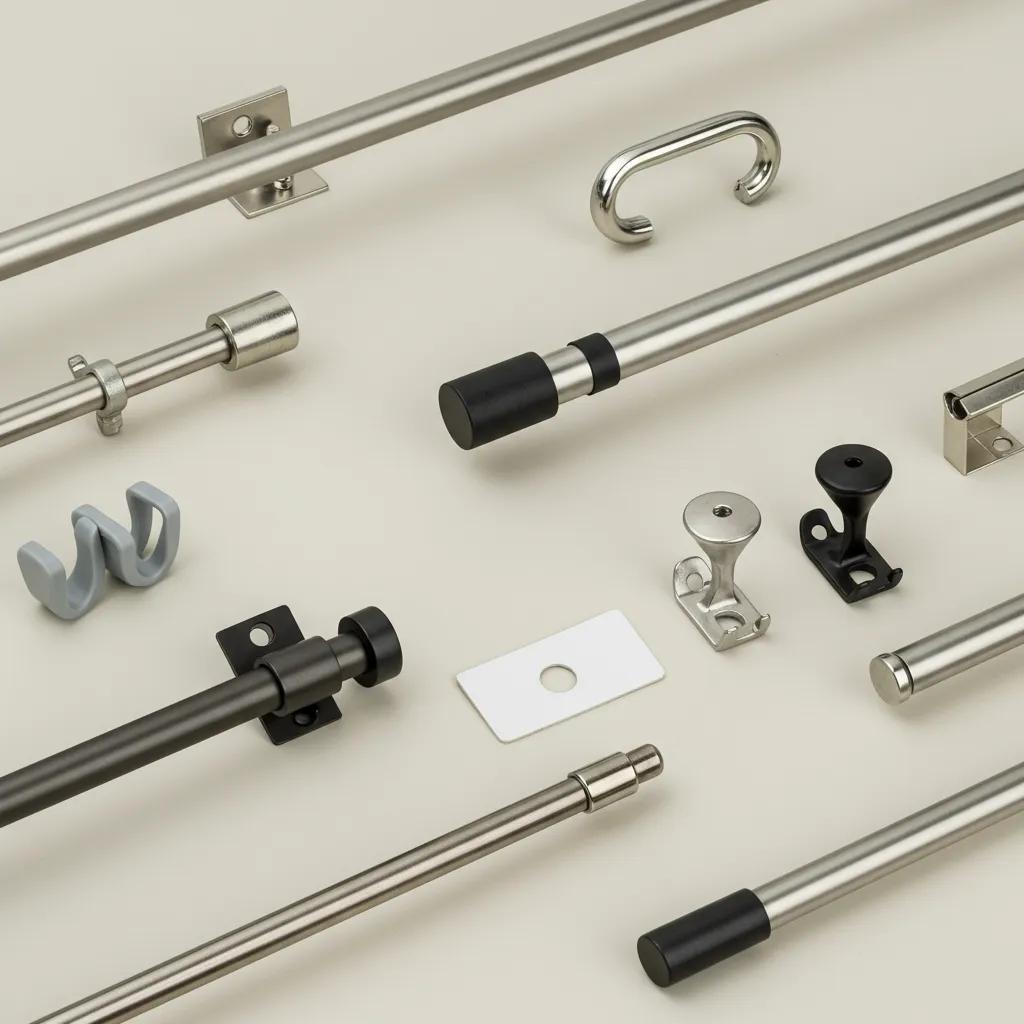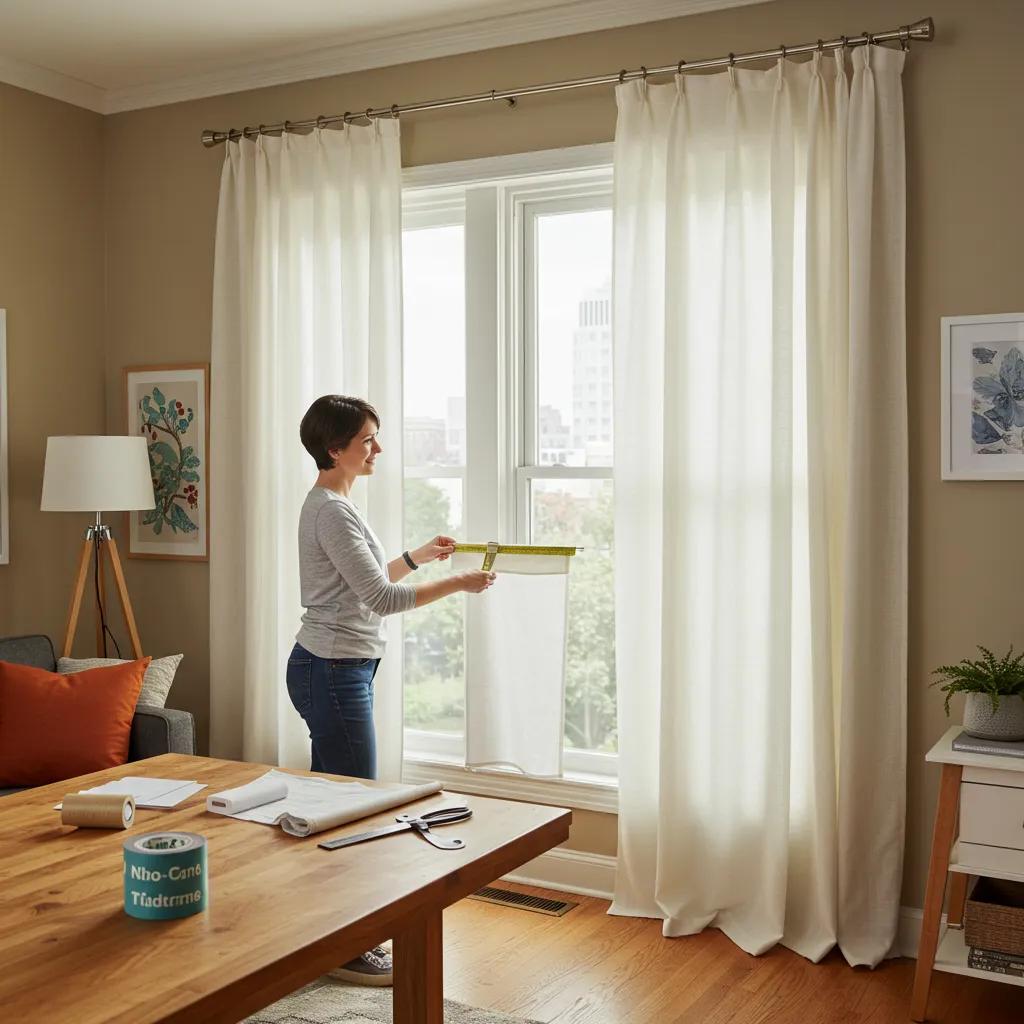Small Space, Big Impact: Easy Curtain Ideas for Apartments and Rentals
Easy and Renter-Friendly Curtain Ideas for Small Apartments and Rentals
Curtains can transform a compact rental into a brighter, more private, and stylish home without risking deposit deductions. This guide shows practical, renter-friendly curtain ideas for small space design, focusing on no-drill installation, space-maximizing styles, designer principles, DIY hacks, and move-out-safe care. You will learn which hardware works on common surfaces, which fabrics and styles boost light and perceived space, and simple step-by-step hacks that avoid damage. The article maps installation options, compares curtain styles by function, outlines design rules to make rooms feel larger, and gives budget-friendly projects and cleaning/removal tips for renters. Throughout, keywords like small space curtain ideas, renter friendly home decor, and tension rod curtain installation apartment are woven into actionable tips you can use immediately.
How Can You Hang Curtains in Apartments Without Drilling?
No-drill curtain methods let renters hang treatments safely and reversibly. These options work by tension, adhesive bonding, magnetic attraction, or clamped brackets, each suited to specific surfaces and weights. Choosing the right method preserves finishes and maintains light control and privacy. Below you’ll find quick pros and cons and a compact comparison to decide fast.
What Are the Best No-Drill Curtain Hardware Options?

Tension rods, adhesive hooks, magnetic rods, and no-drill clip brackets cover most rental needs. Tension rods are best for lightweight panels and narrow frames. Adhesive hooks suit light valances or sheers when surfaces are smooth and clean. Magnetic rods work only on metal frames or doors and are limited by magnet strength.
- Tension rods work with spring or twist mechanisms for friction hold.
- Adhesive hooks require surface prep and curing time for secure bonds.
- Magnetic rods fit metal surfaces and are fast to move.
These choices lead naturally to sizing and weight considerations when selecting a mounting method.
| Hardware Type | Installation Method | Typical Weight Limit |
|---|---|---|
| Tension Rod | Spring/twist tension | ~5–15 lbs depending on diameter |
| Adhesive Hook/Strip | Peel-and-stick mounting | ~2–8 lbs (surface-dependent) |
| Magnetic Rod | Magnetic attachment to metal | ~3–10 lbs (magnet strength) |
This table helps match hardware to window size and curtain weight quickly.
How Do Tension Rods Work for Small Spaces and Rentals?
Tension rods use opposing pressure to stay in place inside a frame or between walls. They are ideal for small windows, shower niches, and inside-frame installations where drilling is not allowed. Matching rod diameter to curtain weight prevents sagging or slippage. Measure inside width, choose a rod with non-slip ends, and test with the panel before final placement to avoid rework.
When Should You Use Adhesive Hooks or Strips for Curtains?
Adhesive hooks work when you need a short-term solution for light panels or valances. Clean, dry, smooth surfaces such as painted trim or tile adhere best after following curing times. Avoid heavy blackout panels on adhesives alone to prevent failure. For safe removal, warm the adhesive and stretch gently to minimize paint pull.
Are Magnetic Curtain Rods Suitable for Rental Apartments?
Magnetic rods are perfect when you have metal door frames, filing doors, or steel window surrounds. Magnet strength must match panel weight; lightweight sheers work best. They avoid adhesives and holes but are incompatible with plaster or wood. Consider aesthetic trade-offs when using fast-move magnetic hardware on visible frames.
Which Curtain Styles Maximize Space and Light in Small Apartments?
Choosing the right style balances light control, privacy, and visual openness. Sheers boost diffuse daylight while keeping rooms airy. Blackout panels create sleep-friendly dark zones in studios without adding bulk if sized correctly. Cafe curtains preserve light at the top of small kitchen windows while giving lower privacy. Below is a quick comparison of common styles to match function with room type.
How Do Sheer Curtains Enhance Light and Privacy in Compact Rooms?
Sheer curtains filter sunlight and reduce glare while maintaining a view, making small living rooms feel larger. Their translucent fabric reflects light back into the room and softens shadows. For more privacy, pair sheers with a removable liner or a second tension rod. Sheers work well when mounted high and wide to maximize perceived window size.
Why Are Blackout Curtains Ideal for Studio Apartment Bedrooms?
Blackout curtains block daylight and increase privacy and thermal insulation, improving sleep in studio layouts. To avoid heavy visual impact, choose lighter colors or layer a slim blackout liner behind a sheer panel. Mounting them close to the ceiling and using slim-profile rods minimizes bulk. Properly sized blackout panels give full coverage without overwhelming the space.
What Makes Cafe Curtains Perfect for Small Kitchen and Bathroom Windows?
Cafe curtains cover the lower half of a window to shield views while preserving top daylight. Their sill-length scale prevents overwhelming small windows and fits well on short rods or tension setups. Use moisture-resistant fabrics like polyester blends for bathrooms and kitchens. Combine them with a slim roman shade for adjustable privacy.
How Do Roman Shades Save Space While Adding Style?
Roman shades fold compactly above the window, clearing visual space and avoiding floor-length fabric. They offer good light control without the visual weight of drapery panels. Many styles mount inside the frame, which suits shallow reveals in rentals. Use tension-mounted shades or clip-on brackets when drilling is not permitted.
Can Vertical Stripe Curtains Create the Illusion of Height?
Vertical stripes draw the eye upward and give the sense of taller ceilings in low rooms. Choose narrow to medium stripe widths with moderate contrast for subtle elongation. Low-contrast stripes are best in small living areas to avoid visual busyness. Pair vertical stripes with high mounting to double the height illusion.
| Curtain Style | Light Control | Privacy | Space Impact |
|---|---|---|---|
| Sheer Curtains | High light | Moderate privacy | Visually expands |
| Blackout Curtains | Low light | High privacy | Can feel heavy unless light color |
| Cafe Curtains | High light | Local privacy | Keeps room airy |
| Roman Shades | Moderate | Good privacy | Compact, space-saving |
This style table clarifies trade-offs for quick decisions in each room.
What Design Principles Help Curtains Make Small Spaces Look Bigger?
Several simple design moves reliably increase perceived space. Light colors and reflective fabrics bounce daylight and reduce visual weight. Mounting curtains higher and extending them beyond the frame widens the perceived window. Layering provides flexible light control without bulk. Follow these rules to maximize the visual footprint of your windows.
How Do Light Colors and Fabrics Expand Small Rooms Visually?
Light colors reflect more light and help walls recede, creating a sense of openness. Fabrics like linen blends and lightweight cotton reflect and drape without weight. Bright neutrals and soft pastels keep the focus on light rather than texture. Use these palettes to amplify natural light and coordinate with small-space furniture.
Why Mount Curtains High and Wide to Maximize Space?
Mounting rods 4–6 inches above the frame and extending 3–6 inches beyond the sides makes windows read larger. This trick increases perceived ceiling height and window width simultaneously. Use tension rods trimmed for width or no-drill brackets to achieve the correct offsets. A quick before-and-after test often shows the most dramatic effect.
| Design Principle | Effect | Quick Tip |
|---|---|---|
| Mount High & Wide | Creates height and width | Place rod 4–6 in above frame |
| Light Fabrics/Colors | Reflects light, lowers visual weight | Prefer linen or cotton blends |
| Layering | Combines privacy and light control | Use double-rod tension setups |
These principles are easy to apply with renter-safe hardware and transform small rooms quickly.
How Does Layering Curtains Improve Functionality and Style?
Layering lets you combine sheer panels for daylight with a removable blackout for privacy. Double rods or curtain clips on a tension rod create a two-tier system without drilling. Layering enhances insulation, sound dampening, and aesthetic depth. Choose complementary textures and keep colors light to avoid visual heaviness.
When Should You Choose Subtle vs. Bold Patterns for Small Spaces?
Subtle, low-contrast patterns keep small rooms calm and expansively visual. Bold patterns can work as a single focal element when everything else is restrained. Use one bold curtain panel paired with neutral sheers to avoid overwhelming the room. Scale the pattern to the viewing distance—smaller rooms favor smaller repeats.
What Are Easy DIY and Budget-Friendly Curtain Hacks for Rentals?

Renters can craft stylish treatments with low-cost supplies and no-sew techniques. No-sew hems, repurposed textiles, and tension-mounted dividers deliver custom looks without holes. Simple steps and thrifted materials reduce waste and expense. Below are practical how-to lists and quick projects suitable for small apartments.
How Can You Create No-Sew Curtains for Small Apartments?
A no-sew curtain project needs only hem tape, fabric or a sheet, and clips or a tension rod. Measure full length and hem with iron-on hem tape following instructions. Attach panels with curtain clips to a tension rod for an instant, removable finish. This method is fast, inexpensive, and landlord-friendly.
- Measure and cut fabric to desired length plus hem allowance.
- Apply iron-on hem tape and press according to instructions.
- Hang with clips on a tension rod and adjust for fullness.
No-sew panels are quick to swap and easy to launder when needed.
What Are Upcycled Curtain Ideas That Save Money and Reduce Waste?
Repurpose bedsheets, tablecloths, or scarves into tailored panels with minimal finishing. Hem tape or binding tape polishes raw edges and gives a custom look. Use pattern placement or dye techniques to make thrift finds intentional. These approaches lower cost while supporting sustainable renter-friendly home decor.
How Can Curtains Be Used as Temporary Room Dividers in Studios?
Curtain dividers create privacy without permanent partitions. Use ceiling tension tracks, tension rods across door frames, or freestanding rod systems for renter-safe separation. Lightweight sheer dividers preserve airflow and light while heavier panels add privacy. Test anchor points carefully to avoid damage and choose methods that remove cleanly.
- Ceiling tension tracks offer the cleanest visual divide where allowed.
- Rods across beams or door frames provide quick solutions.
- Freestanding frames are fully damage-free and movable.
Each approach balances privacy, light, and airflow differently for studio layouts.
How Do You Maintain and Remove Renter-Friendly Curtains Without Damage?
Proper cleaning and careful removal protect finishes and deposits. Follow fabric care codes and use warm water or machine cycles for washable panels. Remove adhesives with heat and slow stretching to avoid paint lift. Small touch-ups like light sanding or matching paint can repair minor marks before move-out.
What Are the Best Cleaning Tips for Temporary Curtains?
Check labels for machine washability; sheers usually launder gently while blackout liners may require dry cleaning. Regular vacuuming with a brush attachment prevents dust buildup in small spaces. For odors, a brief soak with vinegar and air-drying refreshes many fabrics. Treat stains promptly with fabric-appropriate cleaners to avoid permanent marks.
How Can You Remove Curtains Without Leaving Marks or Damage?
Removal depends on hardware type: tension rods compress and pull out easily when relaxed. For adhesive hooks, warm the adhesive with a hair dryer and stretch the strip slowly along the surface to release. Magnetic rods lift clear from metal surfaces. After removal, wipe the area and allow time to air out before repainting if needed.
- Tension rods: compress and remove gently.
- Adhesive strips: warm and stretch to release.
- Magnetic rods: lift directly from metal.
These steps minimize repairs and help secure full deposit returns.
Recommended For You
5.0 / 5.0
17 reviews- Zuri/Natural-White
- Zuri/Gray-Blue
- Zuri/Light Green
- Zuri/Light Pink
- Zuri/Yellow
- Zuri/Sand
4.98 / 5.0
47 reviews- Solene/Purple
- Solene/Dark Gray
- Solene/Light Beige
- Solene/Dark Beige
- Solene/Sand
- Solene/Light Gray
- Solene/Sky Blue
- Solene/Baby Blue
4.91 / 5.0
11 reviews- Olivia/White
- Olivia/Khaki
- Olivia/Light Gray
- Olivia/Brownish
- Olivia/Dark Gray
- Olivia/Mint Green
- Olivia/Navy Blue
- Olivia/Blue
- Olivia/Cream
- Olivia/Dark Brown
- Olivia/Gray
- Olivia/Pink
- Olivia/Grass Green
- Olivia/Dark Green
- Olivia/Black
5.0 / 5.0
26 reviews- Sienna/Black
- Sienna/Light Gray
- Sienna/White
- Sienna/Beige Yellow
4.95 / 5.0
22 reviews- Isabel/Bluish Gray
- Isabel/Cream White
- Isabel/Grayish White
- Isabel/Dark Gray
- Isabel/Sky Blue
- Isabel/Coffee
5.0 / 5.0
4 reviews- Charlotte/Olive Green
- Charlotte/Beige
- Charlotte/Dark Khaki
- Charlotte/Brown
- Charlotte/Lime Green
- Charlotte/Blue Gray
- Charlotte/Peach Pink
- Charlotte/Brownish
- Charlotte/Light Gray
- Charlotte/Steel Gray
- Charlotte/Smokey Purple
- Charlotte/White
- Charlotte/Green
- Charlotte/Orange
- Charlotte/Dark blue
4.33 / 5.0
3 reviews- Celeste/Grayish White
- Celeste/Dark Beige
- Celeste/Dark Gray
- Celeste/Light Gray
- Celeste/Light Beige
- Celeste/Dark Brown
- Celeste/Sky Blue
- Celeste/Blue
- Celeste/Navy Blue
- Celeste/Gray
- Emma/Natural
- Emma/Chocolate Natural
- Emma/Pine Natural
- Emma/Gray
- Emma/Ochre Natural
5.0 / 5.0
5 reviews- Sophia/White
- Sophia/Light Beige
- Sophia/Wheat
- Sophia/Pink
- Sophia/Lake Blue
- Sophia/Navy blue
- Sophia/Light Gray
- Sophia/Dark Gray
- Sophia/Coffee
- Sophia/Brown
- Sophia/Grass Green
- Sophia/Orange
- Sophia/Black
- Sophia/Aquamarine
4.96 / 5.0
25 reviews- Clara/Natural
- Clara/Light Gray
4.92 / 5.0
13 reviews- Heloise/Navy Blue
- Heloise/Grayish White
- Heloise/Light Brown
- Heloise/Sand
- Heloise/Light Gray
- Heloise/Gray
- Heloise/Rose
- Heloise/Dark Blue
- Heloise/Light Blue
- Heloise/Baby Blue
- Heloise/Light Green
- Heloise/Grass Green
- Heloise/Dark Green
- Heloise/Coffee
- Elodie/Dark Gray
- Elodie/Black
- Elodie/Light Gray
- Elodie/Pink
- Elodie/Green
- Elodie/Beige
- Elodie/Gray
- Elodie/Light Coffee
- Elodie/Brown
- Elodie/Blue
4.8 / 5.0
5 reviews- Luna/Dark Gray
- Luna/Light Gray
- Luna/Black
- Luna/Natural
- Aspasia/Cream White
- Aspasia/Gray
- Aspasia/Light Gray
- Aspasia/Blue Gray
- Aspasia/Taupe
- Aspasia/Khaki
- Aspasia/Rose
- Aspasia/Matche Green
- Aspasia/Dark Blue
- Nicolette/Light Beige
- Nicolette/Light Gray
- Nicolette/Grayish White
- Nicolette/Brown
- Nicolette/Cinnamon
- Nicolette/Coffee
- Nicolette/Pinkish Purple
- Nicolette/Light Blue
- Nicolette/Lake Blue
- Nicolette/Blue
- Nicolette/Dark Blue
- Nicolette/Dark Brown
- Nicolette/Dark Gray
- Cecilia/Grass Green
- Cecilia/Cream White
- Cecilia/Tea Milk
- Cecilia/Light Gray
- Cecilia/Gray
- Cecilia/Dark Gray
- Cecilia/Haze Blue
- Cecilia/Kahki
- Cecilia/Dark Brown
- Yvonne/Creamy Cloud
- Yvonne/Warm Beige
- Yvonne/Latte Brown
- Yvonne/Peach Pink
- Yvonne/Silver Grey
- Yvonne/Slate Grey
- Yvonne/Walden Blue
- Yvonne/Royal Blue
- Yvonne/Olive Green
- Yvonne/Avocado Green
- Yvonne/Alice Blue
- Ash1
- Ash2
- Salome/Green
- Salome/White
- Salome/Beige
- Salome/Light Gray
- Salome/Dark Gray




























